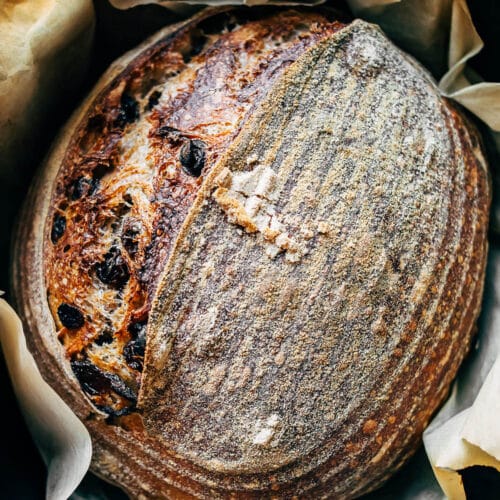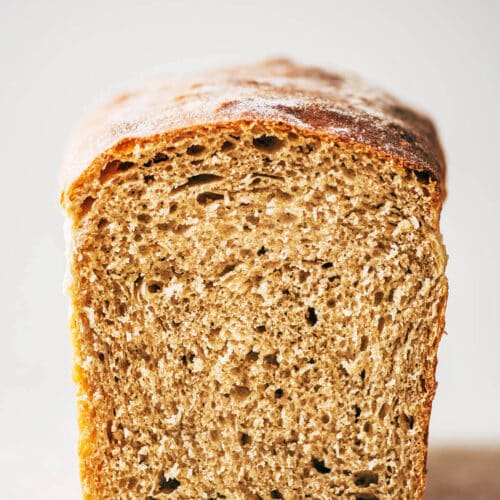This sourdough olive bread is a crusty, rustic loaf studded throughout with salty, briny Castelvetrano olives, but use any olives you like! The chewy airy inside and crisp crust of this bread are the perfect backdrop for any olives you like or have on hand.
For some more fantastic flavoured sourdough loaves, try our apricot sourdough, jalapeño cheddar sourdough bread, or slightly sweet cranberry sourdough.
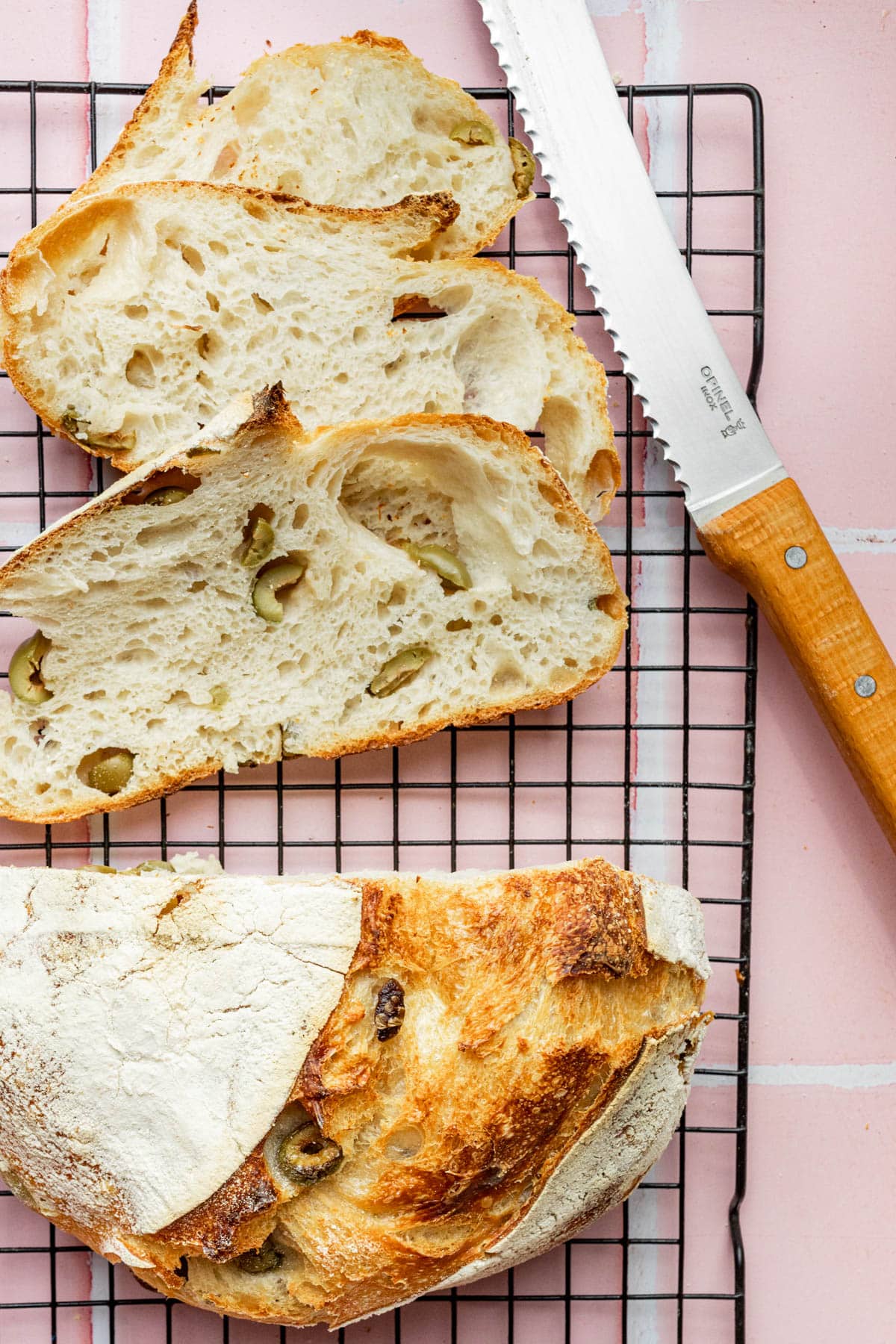
Jump to:
Ingredients
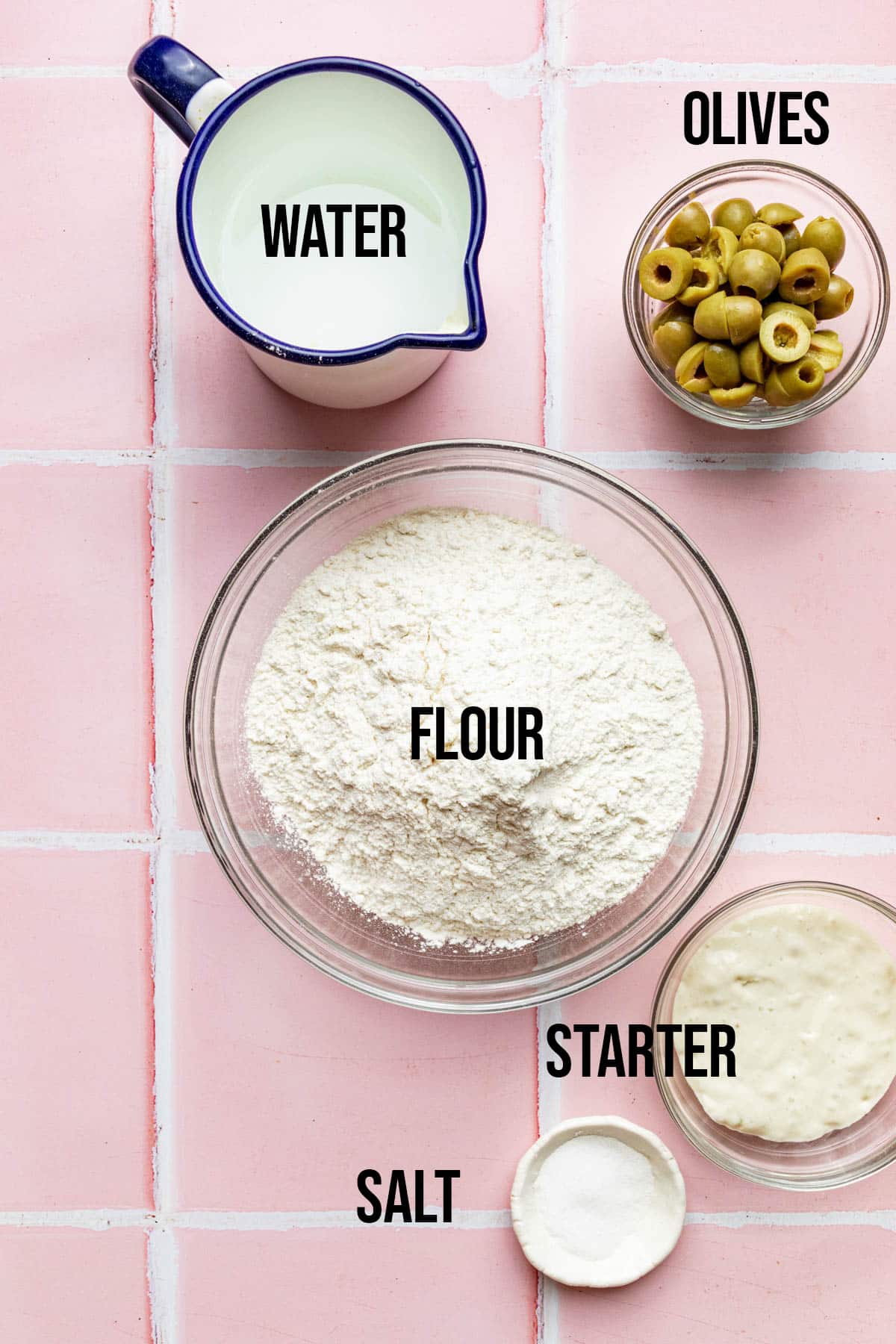
Ingredient Notes and Substitutions
- Olives: We used pitted Castelvetrano olives, but you can use any olives you like (pitted Kalamata olives are terrific in this loaf). For extra intense olive flavour, try adding a few Moroccan olives to the mix, or even try mixing green and black.
- Flour: We use all-purpose flour in this recipe. Strong bread flour, or up to 40% whole wheat can be substituted for all-purpose.
- Sourdough starter: You need an active bubbly sourdough starter to make green olive sourdough bread. If you don't have an active starter, another option is to make a sourdough levain the night before.
Method

Step 1: add the sourdough starter and water to a bowl and stir well to combine.
Step 2: add the flour and mix with your hands until a shaggy dough forms.
Step 3: add the olives and salt and continue to mix in until well distributed.
Step 4: do a series of six stretch-and-folds, every 30 minutes, for a total of three hours.
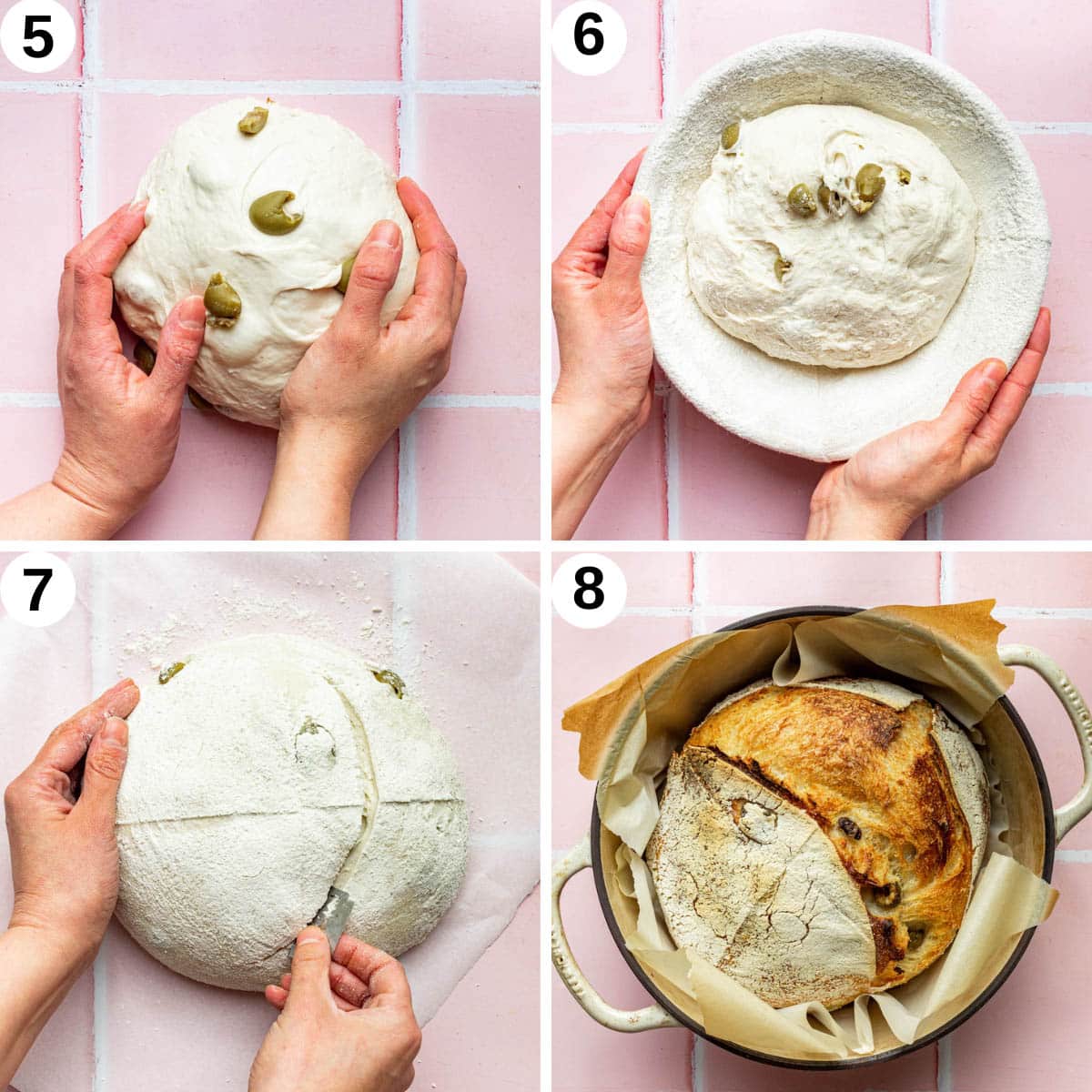
Step 5: shape the dough into a boule (ball).
Step 6: place the dough upside down in a floured banneton and rest in the refrigerator overnight.
Step 7: remove the dough from the banneton, right side up onto a piece of parchment paper, and score with a sharp blade.
Step 8: transfer the dough to a preheated Dutch oven and bake for 20 to 25 minutes. Finish the loaf with the lid off.
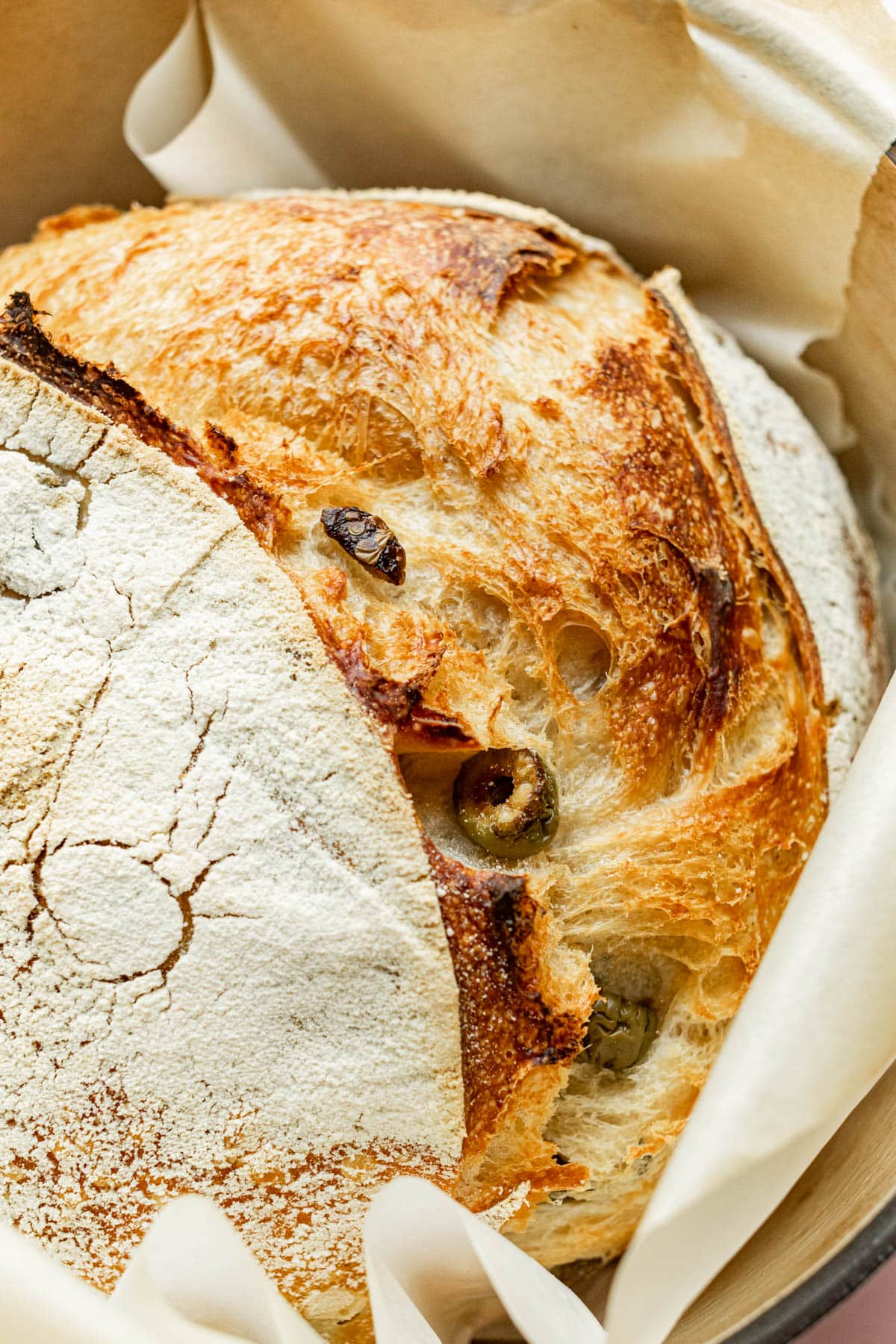
Top Tips
- Keep the olive chunks large: we like to slice whole pitted olives in half for this olive sourdough loaf. Larger pieces ensure maximum bursts of flavour and don’t burn in the oven the way smaller pieces do.
- Tuck in the olives: when shaping, try to keep the olives from poking through the surface tension of the dough, tucking them under when needed. This will help prevent burning!
- Cool fully: let your loaf cool for at least four hours before slicing. A loaf sliced too soon may still be hot and steamy inside which means high probability of gummy bread.
Recipe Notes
We highly recommend using a scale and it is for this reason we don't include US customary volume measurements. Volume measurements can be wildly inaccurate and room for error is large. If you don't own or want to buy a scale we recommend using another recipe.
Another tool that makes a huge difference, not only to sourdough baking but to all baking, is an oven thermometer. You can purchase them for around $5 CAD at most hardware stores. Thermometers provide across-the-board consistency for baking and all of us here at Baked use them.
There is sometimes confusion between the terms "no-knead" and "stretch and folds". They are not the same thing. See this guide on how to do stretches and folds.
Room temperature or slightly warm water encourages activity in the starter. Do not use cold water (unless you don't mind waiting longer).
You can leave your shaped olive sourdough loaf to proof in the refrigerator for up to three days. The longer it sits, the more sour flavour should develop, however, the amount of sour flavour can also depend on your starter's strength and age.
How To Store
Storage: a good method to store your loaf is to wrap it in a clean tea towel and store it in a cold oven. You can also store it in a large paper bag or in a bread bin. It will keep for 3-4 days.
To Freeze: transfer your fully cooled loaf to an airtight container and freeze for up to a month, or freeze individual slices. Frozen slices of no-knead olive bread are great for toasting!
FAQ
Do you need a banneton for sourdough?
Bannetons are nice to have but not crucial. If you don't own one, line a bowl with a clean cotton tea towel. Sprinkle the tea towel generously with flour before placing your shaped loaf in to proof.
What can you put on olive sourdough?
Butter is always our answer, but other options are hummus, cheese, smeared roasted garlic, or even jam! You can't beat sweet and salty. It's also great dipped in olive oil swirled with a drizzle of balsamic vinegar.
Do you need a dutch oven for sourdough bread?
A cast iron Dutch oven (enamelled or un-enamelled) is our favourite tool to bake sourdough but if you don't have one, don't worry. Just use the baking method for our Sourdough Pan Loaf.
If you make this Olive Sourdough Bread recipe or any other sourdough recipes on the Baked Collective, please take a moment to rate the recipe and leave a comment below. It’s such a help to others who want to try the recipe. For more baking, follow along on Instagram, TikTok, and YouTube.
Sourdough Olive Bread (No-Knead)
Equipment
- Mixing bowl
- Dough whisk optional
- Tea towel
- Banneton
- Dutch oven
- Sharp knife or lame
- Parchment paper
- Wire rack
- Measuring cups and spoons or a digital kitchen scale
Ingredients
- 100 grams active sourdough starter or levain
- 320 grams water room temperature
- 440 grams all-purpose flour
- 10 grams sea salt
- 100 grams pitted olives roughly chopped
Instructions
ONE DAY BEFORE BAKING
- Add the active starter and water to a large bowl and mix until well-distributed.
- Add the flour and, using a dough whisk and/or your hands, mix to form a shaggy dough.
- Cover with a tea towel and rest at room temperature for 30 minutes.
- Next, add salt and olives and mix to incorporate.
- Stretch and fold the dough a total of six times, once every 30 minutes over a total of three hours.
- Dust a banneton with flour and set aside.
- Shape the dough into a boule, dusting with flour as needed. Try to keep the olives from poking through the surface tension of the dough, tucking them under when needed.
- Once shaped, turn the loaf into the banneton, seam-side up. Sprinkle flour over the loaf before covering with a tea towel.
- Transfer the shaped loaf to the refrigerator to rest overnight.
DAY OF BAKING
- Place a Dutch oven in the oven and preheat to 500°F (260°C). After the oven has come to temperature, let the Dutch oven continue to preheat for another 30 minutes.
- Once preheated, take the bread out of the refrigerator. Gently invert the dough onto a piece of parchment paper (seam side down) that is large enough to lift your bread into and out of the Dutch oven.
- Score the top of the bread with a sharp knife or bread lame.
- Using oven mitts, carefully remove the hot Dutch oven. Reduce the oven temperature to 450°F (230°C). Remove the lid of the pot, then quickly and carefully lift the dough in using the edges of the parchment paper as handles. Using oven mitts, carefully place the lid back on the Dutch oven and place it back into the oven. Bake for 25 minutes.
- Carefully remove the pot and remove the lid (be careful of steam). Bake the loaf, uncovered, for another 20-25 minutes, or until the bread is golden to dark brown (depending on preference) and crusty.
- Remove the hot pot from the oven. Using the parchment paper as handles, transfer the bread from the Dutch oven to a wire rack. Cool completely before slicing, at least 4 hours, and preferably 6 hours.

